#Visit Assam cultural
Text
#Maha Mrityunjay Temple#Nagaon#Assam temples#Spiritual pilgrimage#Temple architecture#Assam culture#Spiritual retreat#Cultural heritage#Assam traditions#Devotional journey#Sacred places#Travel Assam#Religious exploration#Assamese rituals#Temple visit#Architecture marvel#Peaceful sanctuary#Religious tourism#Spiritual blessings#Temple vlog
0 notes
Text
Hidden Gems of India: Unveiling the Unexplored Treasures of the North and South
Introduction: Are you tired of treading the beaten path and following the hordes of tourists? Do you yearn for something unique, unexplored, and just a tad sarcastic? Well, you're in for a treat! Welcome to the world of underrated destinations in India, where we'll navigate the road less traveled with a twist of humor and a sprinkle of sarcasm.
Why should I care about underrated destinations in India? Well, dear traveler, if you enjoy being herded like cattle in overcrowded tourist spots and waiting in never-ending lines, then this article might not be for you. But if you crave unique experiences, breathtaking landscapes, and a dash of sarcasm, keep reading.
Can you please tell me where to find these hidden gems? Of course! But remember, if you're looking for signs pointing to these destinations every few meters, you won't find them. That's kind of the point, right? Here are some uncharted territories:
Tawang, Arunachal Pradesh: Where Google Maps Gets Confused Let's kick things off in the remote corners of Arunachal Pradesh, where even Google Maps takes a coffee break. Tawang, nestled in the Eastern Himalayas, is a place where your phone signal plays hide and seek, but the landscapes play no games. With the Tawang Monastery as your starting point, you'll wonder why you didn't ditch the crowded hill stations sooner.
History: Tawang is not just a picturesque destination; it's also steeped in history. It's home to the famous Tawang Monastery, which is the largest Buddhist monastery in India and the second-largest in the world. The monastery, dating back to the 17th century, offers a glimpse into the region's rich Buddhist heritage.
Culture and People: The Apatani tribe, the indigenous people of Tawang, add a unique cultural flavor to the region. Their traditional customs and festivals offer visitors a chance to immerse themselves in the local way of life. The warm hospitality of the locals will make you feel like you've found a second home in this remote corner of India.
How to Reach: Getting to Tawang is an adventure in itself. You can take a bus or shared taxi from Bomdila or Tezpur. Alternatively, you could hire a cab from either of these points and let the spirit of adventure guide you through the winding roads and breathtaking vistas.
Keylong, Himachal Pradesh: When the Journey Becomes the Destination Forget about those overcrowded hill stations. Keylong, situated in the Lahaul and Spiti districts of Himachal Pradesh, is a secret paradise for adventure enthusiasts and nature lovers. The journey to Keylong is as captivating as the destination itself, with treacherous mountain passes, gushing rivers, and jaw-dropping landscapes.
Adventure Activities: Keylong offers a range of adventure activities for adrenaline junkies. You can indulge in trekking, mountaineering, river rafting, and even skiing during the winter months. For those seeking a more laid-back experience, there are also options for camping, birdwatching, and simply basking in the serene beauty of nature.
Monasteries and Temples: Keylong is dotted with ancient monasteries and temples that hold great religious and cultural significance. The Kardang Monastery, Shashur Monastery, and Tayul Monastery are a few notable ones that offer a glimpse into the region's spiritual heritage. The Triloknath Temple, dedicated to Lord Shiva, is another must-visit site for devotees and architecture enthusiasts alike.
How to Reach: Keylong is accessible by road from Manali and Leh. The journey is not for the faint-hearted, as it involves navigating treacherous mountain roads and high-altitude passes. However, the stunning vistas and unique experiences along the way make it all worth it.
Majuli, Assam: An Island of Culture and Natural Beauty Nestled in the Brahmaputra River, Majuli is the world's largest river island and a hidden gem in the state of Assam. This tranquil island is blessed with lush greenery, serene riverside landscapes, and a vibrant cultural heritage.
Satras and Cultural Heritage: Majuli is renowned for its Satras, which are institutions of Vaishnavite culture and learning. These Satras preserve ancient traditions, music, dance, and performing arts. Exploring the Satras and witnessing the colorful festivals and dance performances is a captivating experience that immerses you in Assam's rich cultural heritage.
Flora and Fauna: Majuli is not just an island of cultural treasures but also a biodiversity hotspot. The wetlands and marshes surrounding the island attract a wide variety of migratory birds, making it a paradise for birdwatchers. You can also spot endangered species like the Gangetic River dolphin.
Badami, Karnataka: Badami, situated in the Bagalkot district of Karnataka, is a historical and architectural gem that often remains overshadowed by more famous heritage sites. This town is renowned for its stunning rock-cut cave temples, which are a testament to India's rich cultural heritage. Start your exploration at the Badami Cave Temples, and you'll wonder why you didn't delve into this archaeological treasure trove sooner.
Architectural Marvels: The Badami Cave Temples, dating back to the 6th century, are carved out of sandstone cliffs and feature intricate sculptures and impressive architecture.
Historical Significance: Badami was once the capital of the Chalukya dynasty and holds a significant place in Indian history. Explore the ancient fort and the Agastya Lake for a deeper connection to the past.
How to Reach: Badami is accessible by road from cities like Bangalore and Hubli. The nearest railway station is in Badami, making it convenient for travelers interested in exploring this historical marvel.
We have a lot of opportunities to witness the hidden wonders of our homeland. It's a reminder that the world is full of surprises, waiting for those willing to step off the beaten path. India's unexplored regions have left an indelible mark on our hearts, and we hope that this will inspire all of us to embark on our own quests of journey and discovery.
So, fellow travelers, keep your curiosity alive and never stop exploring. There are hidden gems waiting for you just around the corner, whether in your own backyard or in distant lands. Happy travels!
9 notes
·
View notes
Text
Meghalaya Tourism: An Ideal Travel Guide

Meghalaya, meaning "the abode of clouds", is a paradise for nature lovers. This hill station in Northeast India has captivated travelers worldwide with its truly magnificent and enchanting skies. Nestled in the Himalayas, Meghalaya shares its borders with Bangladesh to the east and south and Assam to the north.
Unforgettable Experiences Await
Meghalaya boasts a plethora of tourist attractions, from towering hills and valleys to countless lakes, cascading waterfalls, pitch-black caves, and sacred forests. Panoramic views, misty hills, terraced slopes, flowing waterfalls, and serpentine rivers are sure to enthrall your soul.
Meghalaya will awaken all your senses. From cultural highlights to heart-pounding adventures, numerous unforgettable encounters await the curious traveler.
Cultural Tapestry
Meghalaya's cultural tapestry is woven with numerous threads. The vibrant traditional festivals are a fantastic way to experience the uniqueness of the state's indigenous population. Soak in the customs of the locals and the breathtaking views while learning about the message each festival conveys. Explore some of the state's local history while sampling the various cuisines it has to offer. Get lost in the area's markets and take advantage of the burgeoning nightlife scene. Meghalaya is renowned for its contemporary cultural celebrations that honor local and international artistic talent. Expect a showcase of music, art, intriguing cultural customs, and more.
Top Tourist Destinations
Popular tourist spots in Meghalaya include Shillong, Tura, Jowai, Cherrapunjee, Nongpoh, and Baghmara. There are numerous tourist attractions in Meghalaya that are worth a visit, including:
Shillong (Scotland of the East): Explore Shillong Peak, Elephant Falls, Ward's Lake, Don Bosco Museum, and Umiam Lake.
Cherrapunjee (One of the wettest places on Earth): Witness the awe-inspiring Dain-Thlen, Kynrem, Nohkalikai waterfalls, and the marvel of engineering - Double Decker Living Root Bridge. Explore Mawsmai Cave, Seven Sister Falls, and Wei Sawdong Falls.
Mawsynram (Another contender for the wettest place on Earth): Visit the famed Jakrem Hot Spring and the Mawjymbuin Cave.
Mawlynnong (Asia's Cleanest Village): Experience serenity amidst spotless surroundings and explore the Living Root Bridge and Balancing Rock.
Dawki (Crystal-clear Dawki River): Enjoy kayaking, snorkeling, and camping by the river in Shnongpdeng Village. Take in the scenic beauty of the Dawki River and the Indo-Bangladesh Border.
Best Time to Visit:
March to June: Pleasant weather, ideal for sightseeing and adventure activities.
July to September: Perfect for relaxation and enjoying the beauty of the rainy season.
October to November: Witness the vibrant cherry blossoms in autumn.
December to February: Ideal for hiking excursions and exploring nearby locations.
How to Reach Meghalaya:
By Train: The nearest train station is Guwahati (Assam), 180 kilometers away. Taxis or buses can take you to Meghalaya from Guwahati.
By Air: Lokpriya Gopinath Bordoloi International Airport in Guwahati (Assam) is the nearest major airport. Taxis can take you to Meghalaya from the airport.
By Road: Major cities are well-connected to Meghalaya by roadways.
Travel Tips:
Research local permits required for specific activities.
Book your accommodations in advance, especially during peak season.
Pack essentials like rain gear and comfortable shoes.
Plan your itinerary based on your interests and time constraints.
Budget for your trip, including transportation, accommodation, food, and activities.
Sample the local cuisine - a delightful way to experience the culture.
Respect local customs and traditions.
Rainfall in Meghalaya:
Meghalaya receives an average annual rainfall of 1,150 millimeters. The state lives up to its name, with the sky rarely remaining cloud-free.
Weather in Meghalaya:
Meghalaya boasts pleasant weather year-round with an average temperature of 24°C. The monsoon season brings ample rainfall, enhancing the beauty of the natural landscape. Winters are dry with moderate temperatures.
Ready to Explore?
Meghalaya, with its stunning beauty, rich culture, and diverse experiences, is a destination that will leave you mesmerized. Let Kajaawa Tours & Cabs craft your dream Meghalaya adventure and help you discover the hidden gems of this incredible state!
2 notes
·
View notes
Text
Northeast India-Seven Sisters State of India✨
Seven States in the eastern most part of India
The Northeast corner of India is calling all adventure seekers and nature lovers! Often referred to as the Seven Sisters, these eight states (Arunachal Pradesh snuck in!) boast breathtaking landscapes, vibrant cultures, and some of the friendliest people you'll ever meet. Let's explore a glimpse of what each has to offer:
1. Arunachal Pradesh: The Land of Dawn-Lit Mountains
Imagine snow-capped peaks piercing the clouds, emerald valleys cradling serene monasteries, and rushing rivers carving their way through the Himalayas.
2. Assam: Gateway to the Seven Sisters & Land of One-Horned Rhinos
Assam is the heart of the Northeast, with vast tea plantations blanketing rolling hills. Spot the elusive one-horned rhino in Kaziranga National Park, or cruise down the mighty Brahmaputra River.
3. Nagaland: Where Warriors Dance & Hornbill Festivals Dazzle
Immerse yourself in the rich tribal heritage of Nagaland. Witness the vibrant Hornbill Festival, a celebration of music, dance, and indigenous crafts.
4. Manipur: The Land of Exquisite Dance & Serene Lakes
Manipur is a cultural haven, famous for its graceful Manipuri dance form. Take a boat ride on Loktak Lake, the largest freshwater lake in Northeast India, dotted with unique floating islands made of phumdis (heterogeneous masses of vegetation).
5. Meghalaya: Abode of Clouds & The Wettest Place on Earth ️
Meghalaya lives up to its name, with dramatic waterfalls cascading down lush hills and misty clouds clinging to the peaks. Sohra (Cherrapunjee) holds the record for the highest annual rainfall, making it a haven for trekkers seeking a truly mystical experience.
6. Mizoram: The Sing-Song State & Land of a Hundred Hills
Mizoram's rolling green hills and friendly locals who love to sing will leave you enchanted. Explore hidden waterfalls, trek through bamboo forests, or simply relax and soak in the serenity.
7. Sikkim: Where Himalayas Meet Serenity ️
Sikkim is a trekker's paradise. Hike through the Himalayas, marvel at the beauty of snow-capped Kanchenjunga, or visit serene monasteries nestled amidst the mountains.
8. Tripura: Unexplored Gem & Land of Tripurasundari Temple
Tripura is an off-the-beaten-path destination with a rich history and vibrant culture. Visit the magnificent Tripurasundari Temple, one of the holiest Hindu pilgrimage sites, or explore the untouched beauty of its hills and forests.
2 notes
·
View notes
Text
A Tea Lover's Paradise: Exploring Assam's Tea Gardens
A Tea Lover's Paradise: Exploring Assam's Tea Gardens
Assam, renowned for its lush tea gardens and rich, flavorful brews, offers a unique and immersive experience for tea enthusiasts. The sprawling estates, steeped in history and tradition, beckon visitors to delve into the world of Assam tea, from its cultivation to its exquisite flavors. Here, amidst the verdant landscapes and serene surroundings, one can truly experience the essence of Assam's tea culture.
Contents
Exploring the Tea Gardens
The Tea-making Process
Tasting the Flavors
Beyond the Tea Gardens
Frequently Asked Questions
Conclusion

Exploring the Tea Gardens
A visit to Assam's tea gardens is a journey through time, where one can witness the meticulous process of tea cultivation and production. Spread across vast expanses, these estates are a sight to behold, with rows of tea bushes stretching as far as the eye can see. The air is filled with the sweet aroma of freshly plucked tea leaves, creating a sensory experience like no other.
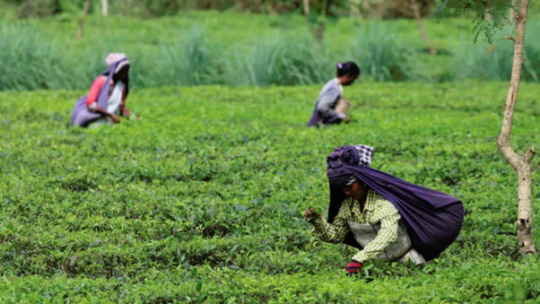
The Tea-making Process
The journey of Assam tea from leaf to cup is a fascinating one. The plucking of the tea leaves is done by skilled workers, who carefully select the young, tender leaves that will yield the best flavor. These leaves are then withered, rolled, fermented, and dried to achieve the distinctive taste and aroma that Assam tea is known for.

Tasting the Flavors
No visit to Assam is complete without indulging in a cup of its famed tea. The rich, malty flavor of Assam tea is best enjoyed with a splash of milk and a hint of sugar, although some prefer it black for a more robust taste. Whether you prefer it hot or cold, Assam tea is sure to delight your taste buds with its bold and invigorating flavor profile.

Beyond the Tea Gardens
While the tea gardens are the highlight of any visit to Assam, the state offers much more to explore. From its vibrant culture and rich history to its scenic landscapes and diverse wildlife, Assam is a treasure trove of experiences waiting to be discovered.
Frequently Asked Questions
1. What makes Assam tea unique? Assam tea is renowned for its bold, malty flavor and bright, brisk liquor. It is grown in the lowlands of Assam, where the hot and humid climate provides ideal conditions for tea cultivation.
2. How is Assam tea different from other types of tea? Assam tea is known for its robust flavor, which sets it apart from other varieties of tea. It is often used in breakfast blends and is prized for its strong, full-bodied taste.
3. Can you visit the tea gardens in Assam? Yes, many tea estates in Assam welcome visitors and offer guided tours of their gardens. These tours provide a fascinating glimpse into the world of tea cultivation and production.
4. What is the best way to enjoy Assam tea? Assam tea is traditionally enjoyed with milk and sugar, although some prefer it black for a more intense flavor. It can be enjoyed hot or cold, depending on your preference.
5. Are there any health benefits to drinking Assam tea? Like other types of tea, Assam tea is rich in antioxidants, which can help boost your immune system and reduce the risk of certain diseases. It is also believed to have anti-inflammatory properties and may help improve digestion.

Conclusion
A visit to Assam's tea gardens is a journey into the heart of India's tea culture, where one can immerse themselves in the sights, sounds, and flavors of this beloved beverage. Whether you're a tea aficionado or simply looking for a unique travel experience, Assam's tea gardens are sure to captivate your senses and leave you with a newfound appreciation for this ancient and cherished drink.
2 notes
·
View notes
Text
Travel Sketches (Nov 2023 - March 2024)
Nov 2023.
Bishnumaya just turned 100 this October. She comes from Pokhari, about 15 kilometers from Mirik town. As we spoke, she recalled old memories, her expressions shifting as if reliving those moments. She seemed elsewhere, gazing past me into the distance, and then, as if continuing a conversation with herself, she said, “Nowadays people ask about caste when they meet someone, and how is that of any use?”
She described how, when she was small, there were no proper schools in her village. She learned to read and write, however little, by arranging corn kernels on the ground to form shapes that resembled letters and numbers. Reflecting on her long life, she added that everyone around her—friends her age and younger siblings—is dead, and she feels like a monster who swallowed them all.

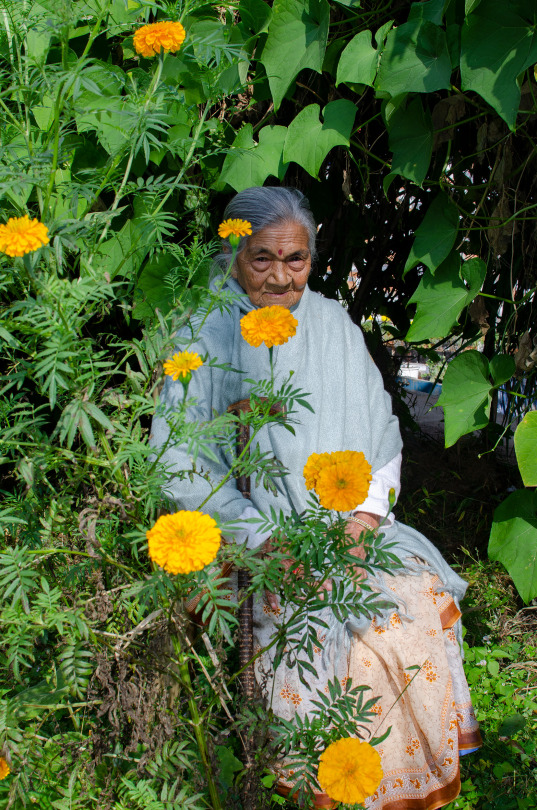

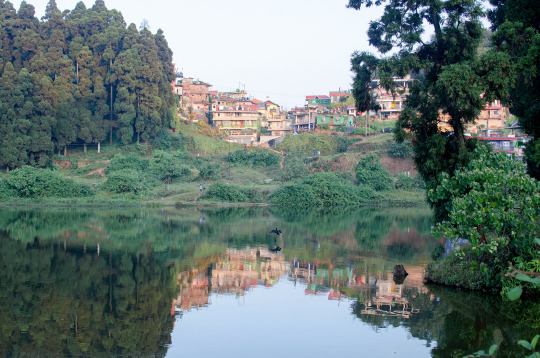
The sun is out, but it’s only warm where the light falls. The history of Mirik is reflected in its lake, which used to be a marshland. According to Wikipedia, the name Mirik comes from the Lepcha words Mir-Yok, meaning "place burnt by fire." It's very green now for a place that was once burnt.
A town fair is underway, offering a range of attractions: a Ferris wheel, flower park visits, fast food stalls, ice cream carts, horse and boat rides, live pop music, card game betting, balloon shooting, local bingo-type card games, and hoopla with prizes up for grabs. Some prizes are cash with notes of 20, 50, and 100 rupees.
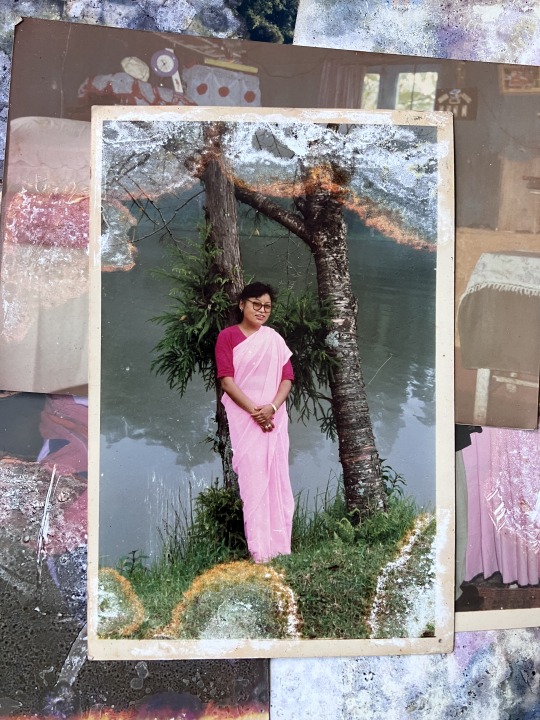
——
For the past ten years, I haven't had a permanent home. When I wanted to sidestep the weight of planning and longed for comfort and familiarity, I returned to places I liked a little more than others: Auroville, Dharamshala, Shillong, Aizawl, Nagaland.
I like meeting new people and have formed what feels like extended families in some of these places. Since I have mostly felt free to move around, sometimes nostalgia of people or a time or a curiosity to see how things may have changed would draw me back to a place.
Earlier in August, while I was temporarily living in Auroville, I got a call about a six-month project called The Great Himalayan Exploration, a collaboration between UNESCO and Royal Enfield. The project aims to document the intangible cultural heritage of local communities in the Himalayan region of Northeast India.
My work on this trip specifically involved photographing the people behind various cultural practices and examining the ecosystems they exist in. To build context, I engaged in various methods, such as scanning old photos from people’s personal albums, taking photos of their living spaces, landscapes, and exploring archival resources. From November to April, we were in West Bengal, Sikkim, Tripura, Mizoram, Assam, Nagaland, and Meghalaya.
------
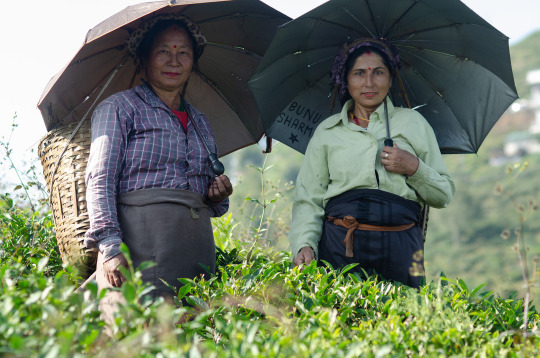
On our way back to Siliguri from Mirik, we made a lengthy stop near a tea estate. Lalita, from Tingling village, shared that she had spent two decades working on the estate, much like many other women from the village. Their collective hope was to earn a minimum of 500 rupees per day for their labor. Currently, they are receiving 250 rupees per day for an eight-hour shift.
------
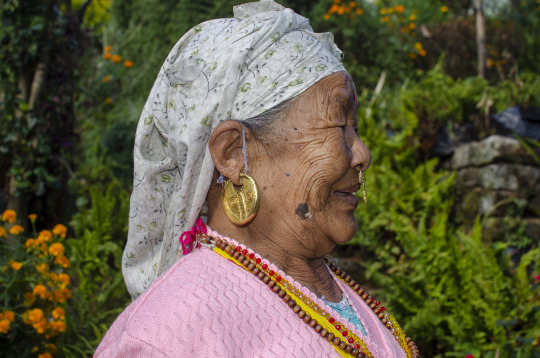
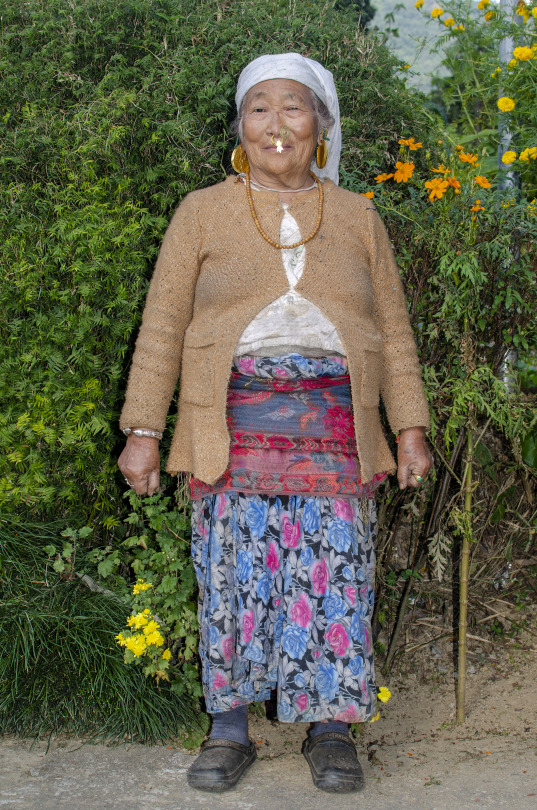
Sanchamaya, 74, sits with her friend Bodhimaya in the front yard of her house in Darap, both lifelong farmers of the area and belonging to the Limbu community. They're nice and welcoming. It's our second day in Pelling, West Sikkim, and I've ended up at the wrong house. Today, we're supposed to see a drum dance(chyabrung) performance by local Limbu boys, which I'll catch later.
They talk in basic broken Hindi, with Shusan translating most of it. Sanchamaya leads me to the back of their house, where she proudly shows me trays of dried large cardamoms. Later, we'll visit her cardamom field. They also cultivate Mosambi, oranges, guavas, maize, peas, ginger, and onions. Sanchamaya spends her days with her friend, grandchildren, working in the fields, and cooking in the kitchen.
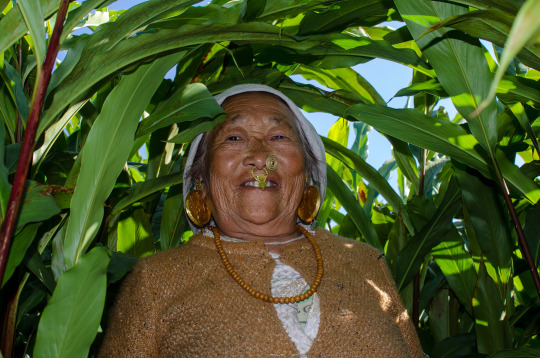

------
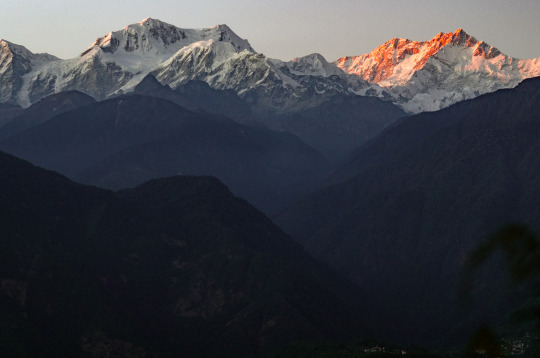
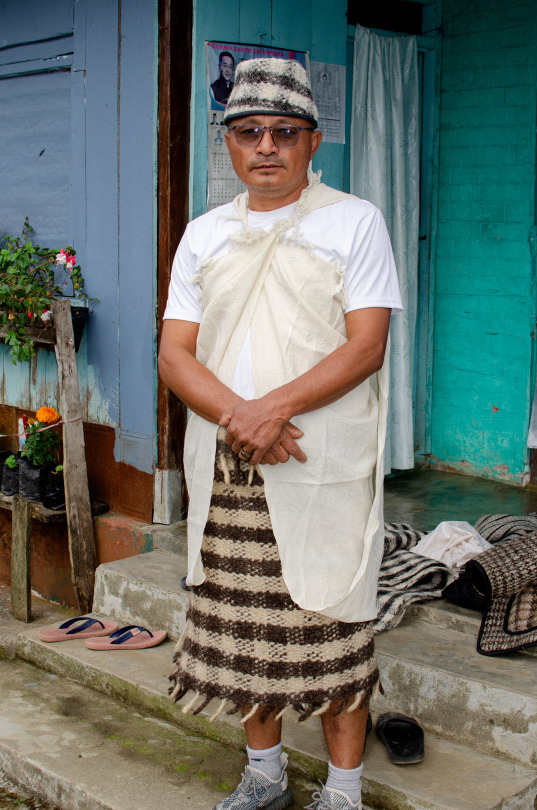
I visited Chuba village, 3 hours away from Gangtok, with Semeon from Haflong, Assam, a textile design graduate from NID and working at Sonam’s design studio called EchoStream based in Gangtok. Semeon was familiar with the village and the community I was there to meet. Arun Gurung and his wife, founders of Chubako, are endeavoring to revive an old tradition of sourcing wool from indigenous banpala sheep to make clothes. They operate a small cooperative called Chubako. In this village of 43 families, one person from each household now works for Chubako. (photo above: Arun Gurung, founder of Chubako)
(photo below: Designed by Sanskruti Shukla, co-created with the craft community of Chubako for Echostream, Gangtok)
Local stories of the craftspeople of Chuba are showcased and incorporated into wool through interactive workshops focused on storytelling and design development. The felted art rugs depict the flora and fauna of Sikkim.
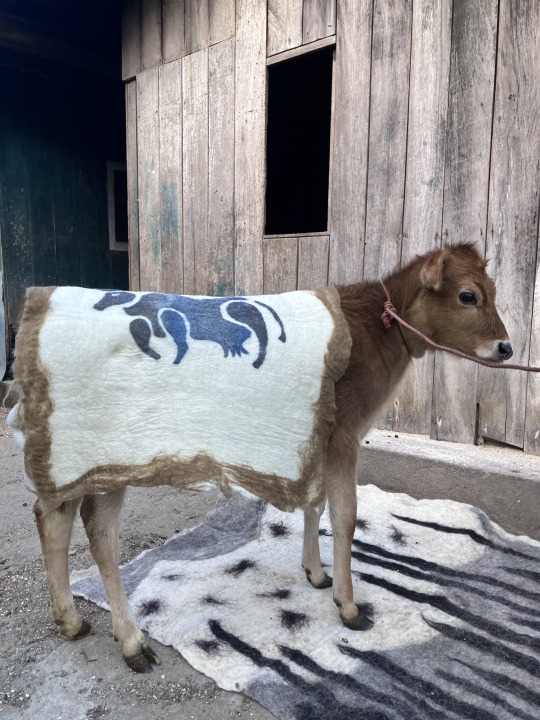


Gangamaya Gurung, 83, Arun Gurung's mother, lit up like a child when she saw Semeon. They shared a bond akin to best friends. Despite her age, Gangamaya remains active, tending to sheep, cutting grass, farming, and weaving. When asked about her leisure activties, she said, "eat, watch TV - eat, watch TV."
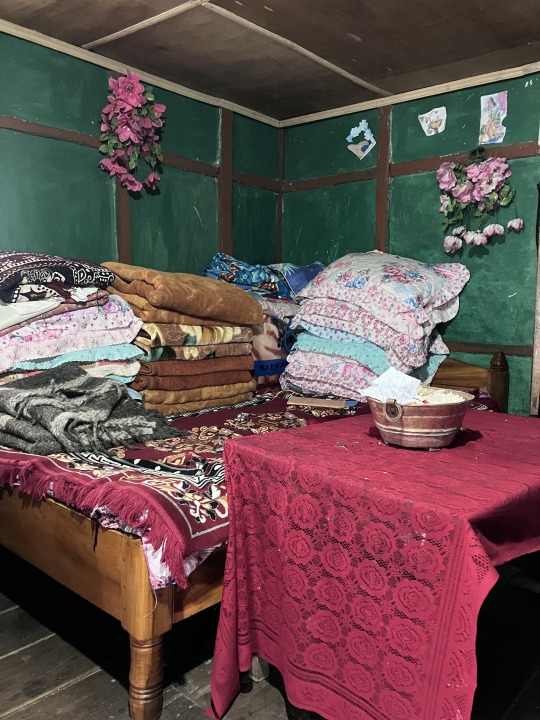
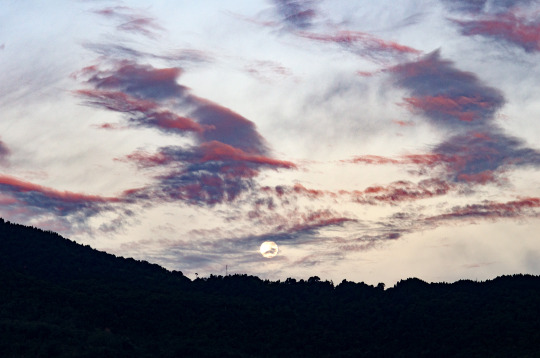

Sampati Debbarma, a farmer, returning from work in Takarjala, Tripura.
--------
Jan, 2024.
We have been out on this trip for 3 months. My thoughts scattered in a kind of bardo between the world I know and the world I am coming into contact with. I picture house fronts with flowers in Darjeeling, roads winding, the long cold rivers snaking toward mountains that seem no bigger than my thumb, the snow capped peaks shifting colours, the prayer flags in high altitudes and on house doors. Gangtok’s Lal Bazaar skateboarders flash by, a school in Tripura where a student lives on 700rs a month, nini bung tamo and 4 other sentences I learned in Kokborok nag me like a tune. Sidangcherra to Pecharthal to Panisagar to Damchara checkpoint we make our way from Tripura into Mizoram by road. I think about where I will be later in the summer and see a white fluffed cloud taking the shape of a growing tree far on the horizon.
——

Krismas Ruaitheh(Christmas feast) at Khatla Presbyterian Church, Aizawl. This is my 3rd time in Aizawl. I used to go for dinners, sometime evening tea to my friend’s family house further up the road from the Khatla church. We are here to document the traditional community feast of the Mizos.

Priscilla is currently pursuing her BA in Political Science in Delhi, and she's home for the holidays. She was volunteering at Khatla Presbyterian Church where she and her friends were tasked with serving lemonade, a customary drink after the meal. For Priscilla, the most remarkable aspect of the feast is its longstanding tradition — dating back to pre-Christian times — where the entire community comes together to share its moments of joy and sorrow + they still use Changel Hnah (plantain leaves) — the traditional way to serve meals.
-----
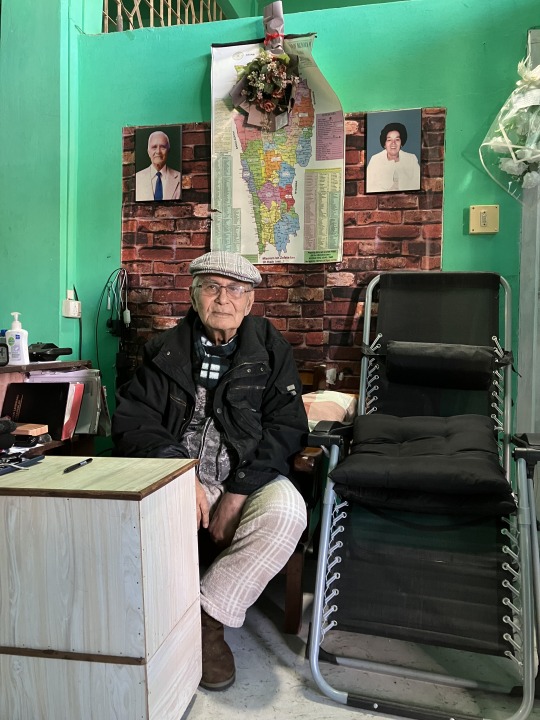
On an idle walk one evening in Khatla, I find myself in a local thrift store and get invited to meet James Lalhmingliana. He is 80, one of the founding members of Aizawl's first bike club, Aizawl Thunders. He went to school at Sts. Edmund’s in Shillong.
In 1966, he joined the Mizo National Front uprising, fighting for freedom. He went underground for seven years, first in Arakan, Burma, then in 1969 to East Pakistan for shelter. "It was useless," he says. "We wasted our good years. When I came back, I was put in jail, but not for long."
He has been housebound for years due to his health.
———


At 8 am on a cold January morning, we arrive at Joonbeel Mela. (Joon and beel are Assamese terms for moon and wetland. The Tiwa community first organized this in the 15th century to exchange goods between indigenous tribal communities in Assam and the surrounding areas.)
It is known as the only fair in India where people still practice barter, exchanging goods like fish, sweet potatoes, yam, homegrown vegetables, turmeric, chili, kali miri, and rongalau.
Over a few hours, I have brief interactions with people from Jagiroad, Pamlatar, Deosal, Sira, Changsari, Potia Pathar, Bengenabari, Palahguri, ulukunchi, morigaon, Nagaon, Saru Amli, Belguri, Damal, and places as far as Langpih, mawlynnong in Meghalaya. No one refuses a photo.
—

This is my fifth time in Nagaland. I first came here ten years ago and stayed at Kevesho's home. He is the father of the Tetseo Sisters, a well-known folk group of four sisters from Nagaland.
Kevesho Tetseo, son of Nülhüprü Tetseo was born in 1950s in Thüvopisümi village, Phek District, Nagaland. Initially schooled in the village, he finished his HSLC at Government High School in Kohima and graduated from Kohima College in Arts. He worked in the Education Dept. for sometime and now retired. Active in cultural music, Chokri language preservation, and in church choir since his youth.
(Tati - - a single string musical instrument which is used as an accompaniment with singing of li- indigenous songs by the Chakhesang Nagas.)
Kevesho learned how to make Tati from observing elders in his village when he was young and has done Tati making work since 1990s and a good number of it has been produced till date by him including improvising it for longer life by using steel wires as strings.
He tells me, the woven shawl he is wearing in the picture is "thipiqhü". It is the most prestigious shawl (indigenous cloth) among many traditional clothes of the Chakhesang tribe. It is a shawl they wear with humility and honour.
“Nagaland is my home and I love my culture, its rich traditional heritage, and the natural beauty.”
-----
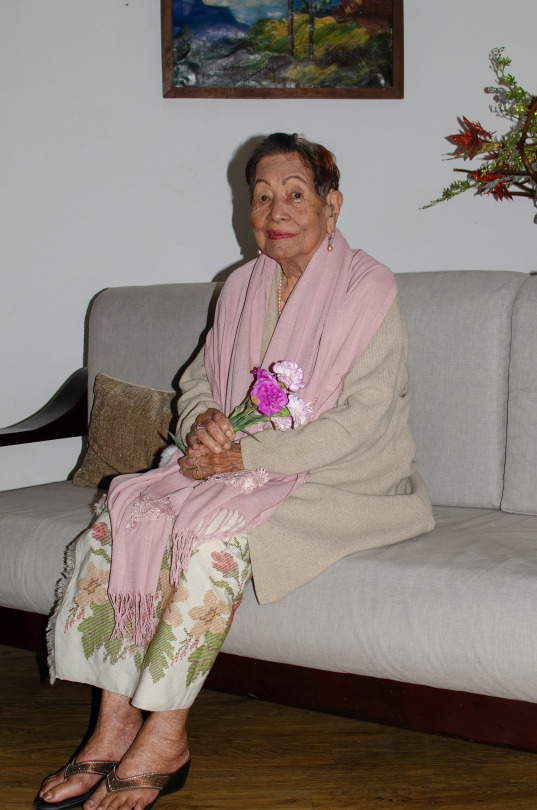
Daisy Yaden was born in Zotlang, Mizoram. She studied at the Welsh Mission School in Mission Veng, Aizawl. She will turn 98 this June. She learned to weave shawls on a backstrap loom, stitching, and baking from her mother, often baking cakes in the fireplace. She taught in the interiors of Nagaland, in places like Noklak and Changtongya. She started her career by teaching people self-sufficiency—how to cook, make jams and pickles—skills she picked up from a British magazine called Woman’s Own. She used to compose little tunes for children at Sunday school. She loves flower gardening and her favourite film is "Gone with the Wind."
Photographed at her house in Duncan, Dimapur.
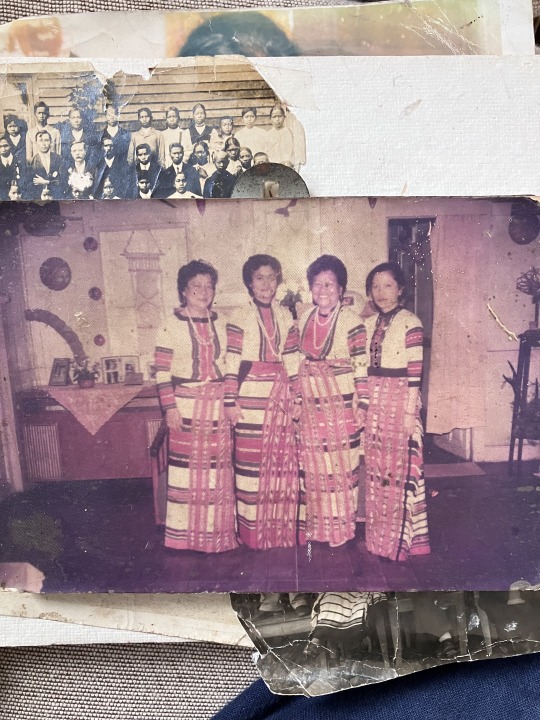
I am sitting with Marian, Daisy's daughter, at her house in Duncan. Marian, now 75, lived in Bombay from 1970 to 2012. She went to college there and worked as an air hostess with Air India for 34 years. In 2012, she returned to Nagaland. We agreed to meet again for lunch and look at her old photo albums.
(below: Marian,16, in Kohima trying a sari for the first time / in Santa Cruz, Bombay in the 80s with James Ferreira and friends)
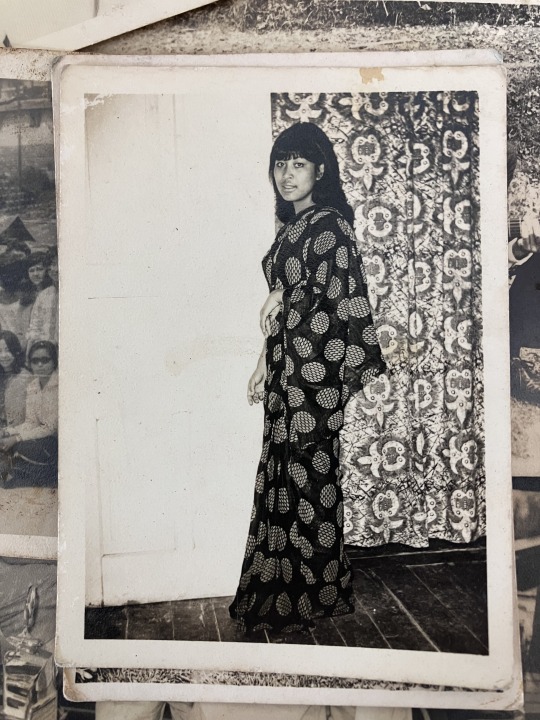


——-
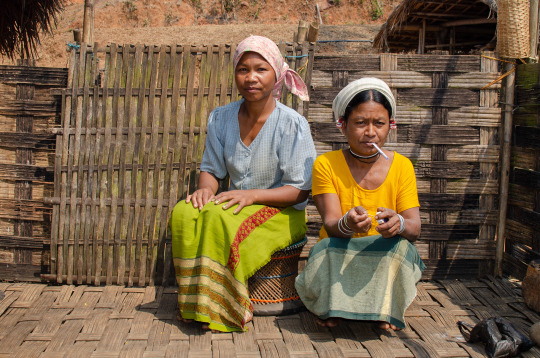
Khinchi is Christian, and Sindri is Songsarek, belonging to one of the last animism practising communities. I learned a few words in Achik: Khading bo, Methela, Namja, and Manja. Here I am in the extended kitchen space at Sindri's hut, in Sadolpara, Dadenggre, where they are taking a break from cooking lunch.
-----
First published in Hindustan Times June '24
0 notes
Text
10 Offbeat Places in Assam
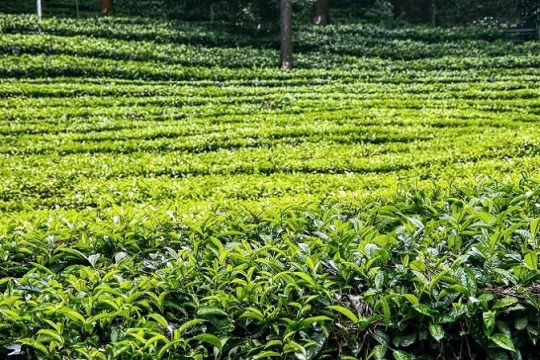
10 Offbeat Places in Assam
Assam, a beautiful state in Northeast India, is known for its tea gardens, wildlife sanctuaries, and stunning natural beauty. However, there are also some offbeat places in Assam that are worth visiting. Here are 10 of them:
Haflong: Located in the Dima Hasao district, Haflong is the only hill station in Assam. It offers beautiful views of the surrounding hills and valleys, and is a great place for trekking and camping.
Majuli: Majuli is the world's largest river island and is located on the Brahmaputra River. It is a cultural hub of Assam and is known for its traditional arts, crafts, and music.
Sivasagar: Sivasagar was the capital of the Ahom Kingdom and is home to several historical monuments such as the Rang Ghar, Talatal Ghar, and Kareng Ghar. It is also known for its traditional Assamese cuisine.
Manas National Park: Manas National Park is a UNESCO World Heritage site and is known for its diverse wildlife, including tigers, elephants, and rhinos. It is also home to several indigenous communities.
Digboi: Digboi is an oil town located in the Tinsukia district. It is home to the oldest operational oil refinery in Asia and is known for its colonial architecture and tea gardens.
Umananda Island: Umananda Island is located in the Brahmaputra River and is home to the Umananda Temple, dedicated to Lord Shiva. It is also a great place for birdwatching and river cruises.
Jatinga: Jatinga is a small village in the Dima Hasao district and is known for its mysterious bird suicides. Every year, during the months of August and September, several migratory birds are found dead in the village.
Hajo: Hajo is a pilgrimage site for Hindus, Muslims, and Buddhists. It is home to several ancient temples, mosques, and Buddhist stupas.
Pobitora Wildlife Sanctuary: Pobitora Wildlife Sanctuary is located in the Morigaon district and is known for its one-horned rhinoceroses. It is also home to several other species of wildlife such as leopards, wild boars, and deer.
Jorhat: Jorhat is a major city in Assam and is known for its tea gardens and golf courses. It is also home to several historical monuments such as the Gibbon Wildlife Sanctuary and the Dhekiakhowa Bornamghar.
Which city is very beautiful in Assam?
Assam is home to several beautiful cities, each with its own unique charm. However, if you are looking for a city that is known for its scenic beauty, then Guwahati is a great option. Located on the banks of the Brahmaputra River, Guwahati offers stunning views of the river and the surrounding hills. It is also home to several temples, parks, and wildlife sanctuaries, making it a great destination for nature lovers. Other beautiful cities in Assam include Jorhat, Tezpur, and Dibrugarh.
Which is the best place in Assam for picnic?
Assam has several beautiful places that are perfect for picnics. Here are a few options:
Pobitora Wildlife Sanctuary: Pobitora Wildlife Sanctuary is located in the Morigaon district and is known for its one-horned rhinoceroses. It is a great place for a picnic as it offers beautiful views of the grasslands and the wildlife.
Deepor Beel: Deepor Beel is a freshwater lake located near Guwahati. It is a popular spot for birdwatching and is a great place for a peaceful picnic.
Chandubi Lake: Chandubi Lake is a natural lake located in the Kamrup district. It is surrounded by hills and forests and is a great place for a picnic with family and friends.
Kakochang Waterfalls: Kakochang Waterfalls is located in the Jorhat district and is a popular picnic spot. The waterfall is surrounded by lush green forests and is a great place for a dip in the cool waters.
Hoollongapar Gibbon Wildlife Sanctuary: Hoollongapar Gibbon Wildlife Sanctuary is located in the Jorhat district and is home to several species of primates, including the Hoolock Gibbon. It is a great place for a picnic with a touch of wildlife adventure.
These are just a few of the many options for picnics in Assam. Be sure to check weather and safety conditions before planning a picnic in any location.
Which is the most visited place in Assam?
Assam is a beautiful state with several popular tourist destinations. However, the most visited place in Assam is Kaziranga National Park. This UNESCO World Heritage site is home to the world's largest population of one-horned rhinoceroses and is also home to tigers, elephants, and several other species of wildlife. The park is known for its beautiful landscapes and is a popular destination for wildlife enthusiasts, nature lovers, and photographers. Every year, thousands of tourists from around the world visit Kaziranga National Park to experience its natural beauty and wildlife.
Which place in Assam is the tourist keen?
Assam has several places that are popular among tourists. However, the place in Assam that tourists are most keen to visit is probably the Kaziranga National Park. This national park is home to the world's largest population of one-horned rhinoceroses and is also home to tigers, elephants, and several other species of wildlife. It is a UNESCO World Heritage site and is known for its beautiful landscapes and rich biodiversity. Tourists are often keen to visit Kaziranga National Park to experience its natural beauty and wildlife, and to participate in activities such as jungle safaris and birdwatching.
Which is Assam's only hill station?
Haflong is the only hill station in Assam. It is located in the Dima Hasao district, about 310 km south of Guwahati. Haflong is situated at an altitude of about 680 meters above sea level and is surrounded by hills, forests, and waterfalls. It is also home to several tribes such as the Dimasa, Hmar, and Zeme Nagas. The town is known for its scenic beauty, cool weather, and adventure activities such as trekking, hiking, and paragliding. Haflong is a great destination for those looking to escape the heat and enjoy some time amidst nature.
Where is the Butterfly Park in Assam?
The Butterfly Park in Assam is located in the Pobitora Wildlife Sanctuary. It is situated in the Morigaon district, about 50 km east of Guwahati. The Butterfly Park is a part of the Pobitora Wildlife Sanctuary and is dedicated to the conservation and breeding of various species of butterflies. The park has a wide range of plants and trees that are required for the breeding of butterflies. Visitors can see the various stages of butterfly development and learn about the different species of butterflies found in Assam. The Butterfly Park is a popular attraction in Assam, especially for nature lovers and those interested in wildlife conservation.
Read more
3 notes
·
View notes
Text
BIHU:ORIGIN ,TRANSITION AND MODERNITY By Arup Saikia
India is land of festival. Culturally regional nationalism is main uniting thread of socially, politically diverse country like India. Bihu is national festival of entire Indian state of Assam.
Nobody knows when or how bihu was created ,but it is invariably confluence of three major cultures of Austro-Asiatic,Indo-Aryan and Tibeto-Burman.Later many immigrants from India and abroad including Muslims imbibe the Assamese culture and subscribe to flourish Bihu syncretizing with their own cultural elements and finally attained today's form.There is three different types of Bihu-Kati,Magh and Bohag celebrated in three agricultural period of life.
BIHU WORD:Deori people called Bihu as BISU(excessive joy). With historical evidence Bihu was carried by Deori, Chutiya and Kachari people from late twelve century in Sadiya based Chutiya Kingdom.But other Bodo kachari tribes like Tiwa,Rava,Mikir,Dimasa celebrate Bihu as Busu,Pisu,Busy Dima or Dumsi etc.But Bodo has uniquely address Bihu as Baisagu.Later simplified and partially sanskritised name popularly became Bihu.
RELIGIOUS ORIGIN OF BIHU: Bihu has been celebrated by various tribes of Bodo-kachari origin since ancient times. But as stated above mediaeval Bihu is started from Sadiya Kingdom led by Chutiya.Copperplate inscription was found in Lakhimpur district (Erstwhile part of chutiya empire). Where, clearly mentioned,king Lakshminarayan on 1401AD granted land to Brahmins on auspicious occasion of Bihu.
Bihu performance started from first week of Assamese month CHOT to last intervening night until start of month BOHAG.On the floors of THAAN(temples) dedicated to KECHAI-KHATI,DIKKARAVASINI or KOLIMOTI.Youngsters danced throughout night until last intervening night of CHOT.Being performed in night, this is called Rati(night) bihu. Very vigorous dancing postures of dancers believed to be attributes of Goddess.This is considered as indication of Goddess (Kolimoti)descended from heaven. Urukuwa or uruka start after perceived arrival of Goddess Kolimoti or Kechai-khati on earth in the end of month chot.Urukuwa or uruka is Sadiya-Kachari term means to end.
Next day of Uruka is Goru(cattle)bihu.On night of Goru bihu young people again danced in temples sacrificing animals to Deity.Then young people in folk visited village households to perform bihu which is called HUSORI.The tradition of starting HUSORI from temples by Sadiya-Kachari and other Tibet-Burma people gradually replaced by NAMGHAR(Assamese prayer house)for Arayan influence.Human sacrifices were also done on altar of Sadiya.But on occasion of Bihu it's clearly not known.
THEME OF BIHU:
Bohag or Rongali bihu is originally dance-centric natural platform for youngsters to express love and joy. First lyrics of bihu were called 'Bonoriya Geet 'i.e wild song of young hearts longing for lovers. 'Bonoriya Geet'(wild song)or bihu rooted its origin in paddy fields, jungle while grazing cattle far away from human settlements- suitable place to express suppressed longing and craving through these songs. Therefore songs have erotic undertone.
BIHU AND BHAKTI MOVEMENT:
During bhakti (devotion)or neo vaishnavite movement from 15th century onwards under Assamese polymath,social reformer Saint Sankerdeva and teachings of his newly created religion EK SARAN(Motto-one supreme soul in universe)more energetically synthesized Assamese society breaking strict age old boundaries of caste or class system.
Although there was no direct influence on bihu for social renaissance-Sankerdeva has initiated by preaching his revolutionary religion (EK SARAN or devotional movement).But way and outlook of bihu perfomance had been changed dramatically. Some spiritually refined words and name of some hindu Gods taken in HUSORI(one kind of male bihu).Praying and blessing in the name of hindu Gods in Husori is effect of Bhakti movement.
ROYAL RECOGNITION OF BIHU :
During heyday of Ahom dynasty on 1696 Ahom monarch Rudra Singha patronized bihu for the first time by inviting or permitting to perform in courtyard of Ranghar (house of joy).Immediately once considered a low key festival celebrated by few in riverbank or cultivation field,became widespread festival embraced by all people traversing different ethnic groups, caste and communities. Consequently a new form of Assamese cultural nationalism had emerged.Songs are changed from erotic or sensuous to panergyric type i.e-song sung praising king and his deeds.
PARTICIPATION OF FEMALE:
Exact date isn't known when male and female allowed to dance together, which once considered social taboo.It's probably after royal recognition under Ahom monarchy,both sexes were started to participate together in bihu.
BIHU UNDER BRITISH RULE:As a result of treaty of yandaboo(1826)signed between British and Burma, British entered and began to rule Assam. Before advent of British,Assam was politically ruled by two administration-one by Ahom dynasty in almost upper Assam upto Nowgong and lower Assam from Nowgong onwards by koch kingdom .British virtually unified Assam and cultural exchange began between two prior disbanded state.Eventually popularity of bihu spread to lower Asssm also and incarnated as festival of whole Assam.
However in nineteenth century some new english educated Assamese intelligentsia like Haliram Dhekial Phukan, Anandaram Dhekial Phukan, Gunabhiram Baruah, Kamalakanta Bhattacharya demoralized Bihu as dance of vulgar and barbarian. But by grace of cultural maestro Jyoti prasad Agarwala, literateur Lakshminath Bezbaruah, Poet Raghunat Choudhury, social worker Radha Govinda Baruah, Bihu had been widely promoted.
TYPES OF BOHAG BIHU:The most popular unique show of Bohag bihu is dance ,variably associated with different kind of bihu.
(I)HUSORI=Performed on courtyard of villagers started in 1896 in the courtyard of Ranghar (house of joy).Previously male only troupe, but now females also participate.
(II)MUKOLI BIHU =Performed in open space, boys and girls mingling together.
(III)JENG BIHU/RATI BIHU=Traditionally it is direct counterpart of men only HUSORI. Performed by women folk only.In JENG bihu no musical instrument is used.RATI Bihu is supposed to celebrate at night away from men's eye symbolizing women liberation. Repertoire is the same of JENG bihu.
(IV)GOS TOLOR BIHU=Bihu under a banyan or big tree.It is previous version of MUKOLI bihu.
(V)FAAT BIHU =Prevalent modern postures of Bihu dance imitated from Faat bihu.Celebrated in Mohguli Chapori near Charikoriya river of Dhakuwakhana. It is one of the oldest Bihu of Assam.Faat means trading place or torn out. It's believed that traders from different places assembled there for bihu celebration.Moreover sections of people dispersed from Sadiya for Ahom-Chutiya conflict believed to be main motivational force behind this festival.For uncontrolled excitement and gaieties performers clothes were torn into strips and musical instruments were cracked. So this Bihu may be named as FAAT Bihu.
DIFFERENT DANCE AND ORCHESTRA
(I)KHUPAT DHORA DANCE =Female bihu dancers dance swaying to orchestra of Dhol(drum),Tal(cymbals) Hutuli(made from mud),flute, Toka and Gogona(both are made of bamboo).This dance posture is to place dancers' hands at the nape of their neck.
(II)TAKURI GHURA NACH=Dancing very speedily and pirouetting at the same place,dancers partially became invisible.
(III)POKHILA URADI NACH=Dancing like butterfly. Hands move like wings of a butterfly.
DIFFERENT FOOTSTEPS IN DANCE :
(I)MOKORA BULONI=Dancers move their feet like a spider.
(II)PORUA BULONI=The feet motion of a dancer is like an ant,goes in row to particular direction.
PRESENT BIHU =Bihu survives since time immemorial through many socio-cultural upheavals changing its form as time demands. Starting from farmland ,Bihu reached digital world via stage, will remain alive as long as Assamese live.
ABOUT WRITER:Arup Saikia is an alumnus of Delhi University. He is noted cultural activist, actor, scriptwriter and poet-authored two poetry books namely SILPI SATTA and SABDA.As director ,actor and translator he has performed BHAONA in English language for the first time from Assam in India and abroad.
email [email protected] phone -+919954050690

#history#Bihu#Chutiya#Ahom#Arup_Saikia#Dance#Sankerdev#Traditional _dance#British#Kachari#Deori#Sadiya#bohagbihu#Maghbihu#Uruka#Kechai_khaiti#Ranghar#Mukolibihu#Faatbihu#Jengbihu#culture
3 notes
·
View notes
Text
It's Been Oolong Time || Andy & Meera
TIMING: current.
PARTIES: @the-haunteang & @declinlalune
SUMMARY: andy visits meera's teashop!
CONTENT WARNINGS: none.
The Best Exotic Herbal Tea Shop was more commonly known as Sharma Tea, mostly because the family that has operated the long-time business was the Sharmas. Meera was its current owner, having taken over after her mother passed away, who herself had taken over when her own mother, Meera’s grandmum, passed away years ago. Strangely, neither of those woman came back to haunt the medium, despite every other dead relative doing so randomly. Meera often thought about that, and as a new customer walked in, she was thinking about it again.
“Welcome to Best Exotic!” Meera instinctively greeted the other woman, jolting to her senses as soon as the door swung open. Right next to it, she could see the same relative from decades ago standing there, just staring at the medium. This gaunt ghost, Meera did not know, only that it must be a grand-uncle that she has never met. It has not spoken to her, and it usually just stood there at the doorway, watching…things. “How may I help you today?”
Andy knew that Sharma Tea was probably her best bet for getting quality tea that wouldn’t curse her or something. She had had their oolong before, and it was something she always came back to, even though she felt the need to venture out for the sake of putting something in the cabinet that Kaden wouldn’t scoff at. Even if the tea became pricey, Andy felt as though she could foot the bill, because really, she drank tea all the time.
Entirely oblivious to those who may be around her aside from Meera, Andy smiled at the woman as she was welcomed in. “Hey! We spoke online, I think, forever ago– I’m here for the Taiwanese oolong you had mentioned?” She should have written the name down so that she could remember, but did it really matter? Meera was an expert in teas, and realistically, she could probably throw an essence of the kind of tea she wanted and the other woman would be able to pin it down with ease. “If you don’t have any more of it, I’m definitely okay with trying something different…?”
Meera tilted her head to one side. Spoke online? Meera had spoken to many people online, and maybe that was the point, but she did find delight in having her marketing ploy succeed. Well, it was less of an actual marketing ploy than just her begging people to come and buy things at the shop, even though they weren’t entirely struggling.
The shop was doing fine. People were buying tea at a pretty decent rate. They had no problems on the financial side of things. Perception-wise, however, Meera had always had a nagging feeling she could do better, she should do better, and maybe that’s just because of the ghosts of her relatives that would not let her stay at peace. “Oh, hello! I’m Meera,” she extended her hand for a quick shake before scrambling toward the mentioned tea. The browsing was less quicker but when she finally found it, she exclaimed excitedly. “Here it is!”
“Oh, well,” Meera found herself deep in thought. What else could she offer this pretty woman? Tea-wise, of course. Something different? Why not her? Err, from her culture? “Have you tried Assam or Darjeeling?” She asked with a wide grin.
As Meera extended her hand, Andy smiled. She shook the woman’s hand before letting her gaze wander over the glass and steel containers that were in just about every corner of the shop. Once she had had her fill, she turned her gaze back to Meera. “I’m Andy.” The introduction didn’t take very long, because Meera was veering off in the opposite direction towards a shelf which had an assortment of different teas.
With her tea found, Andy was fully prepared to take out her wallet and buy as much as she could afford. She was sure it wasn’t cheap, but for quality tea, it was worth it. At Meera’s question of whether or not she’d ever had Assam or Darjeeling, Andy thought for a moment before nodding. “I’ve had Assam, but not Darjeeling… is it a black tea, too?” She didn’t really know a ton about tea or coffee, but she liked it enough to drink it, and that was good enough for her. If Meera were to suggest something else she might like, Andy would take it gladly.
“Yes, it is,” Meera began to explain with a wide smile on her face. If there was one thing that made her glad she was alive, unlike her annoying relative that was eavesdropping on the conversation between two living people, it was the fact that she was at least very well-versed in the field of tea. “Well, Darjeeling can actually come in other varieties but the black tea version is very exquisite! It’s also extremely rich in antioxidants and has a beautiful full-bodied flavor!”
Meera handed the box of Darjeeling tea to Andy, keeping the Assam with herself just in case she wanted to go with what she already knew. Most people enjoyed trying out new stuff, but when it came to tea, as with anything food-related, a lot actually preferred to still go with the ones they’ve already had. If she was lucky, she’d take something new with them, too, but even then, not a lot of her customers ventured toward the strange and unknown. At least not on the first visit. “Is it a bit pricey but I can brew you a cup if you’d like a taste first? It’s on the house!”
It shouldn’t be, as Meera’s unintentional glimpse of the gaunt ghost at the door revealed, but she didn’t really have a lot of opportunities to defy her dead relatives, so this was as good as it gets.
When Andy thought of tea, she only ever thought about whether or not it tasted good, or if it’d make her caffeine intake shoot through the roof. For the most part, she never thought about whether or not it could be good for her. But as Meera explained antioxidants– whatever those were, Andy found herself listening intently. Sure, she could use some of those. They sounded good for you, and Andy could always use a healthier alternative to the peach rings she ate nearly every other day.
Andy took the box of Darjeeling with a grateful smile, turning it over in her hand, taking note of the benefits that were labeled on the back. She read over them before looking up at Meera as she offered to brew a cup on the house. “Really? You don’t need to do that.” She always felt guilty getting free things, which was rich, considering all the theft she and Alex had committed. Even now, she still found herself stealing from the people who wouldn’t miss what she took.
“I can grab a few ounces to try, if you weigh by that?” Most tea shops did, but Andy knew that for certain teas, they’d only sell by an already pre-packaged amount for the sake of not losing stock or money. “If not, it’s alright– um, how expensive are we talking?” Her wallet had felt light in the past few days, but it wasn’t an issue, especially because tea usually lasted her a long while.
“You know what?” Meera’s lips curled into a bright smile, her eyes joining in the fun. She was impressed and appreciative with this customer, Andy, mostly at her declining her offer of a free taste. Normally, most customers, especially new ones, would jump at the offer, as it was a pretty risk-free way of trying new flavors, new tea. It wasn’t that great of a loss to the shop, too, as they could use the same pre-packaged box for the source of all succeeding free tastes. “Why don’t I give you a discount? Since it’s your first time trying Darjeeling.”
Meera grabbed another box of Darjeeling tea and handed it to Andy. “This is 2nd flush, bolder in flavor than what you have in your hand, which is 1st flush,” she explained with a smile, eager to impart what she knew of her trade, which was pretty much a lot. “The 2nd flush has a subtle fruity and musky complexity, which makes it perfect for an afternoon cup, while the 1st flush is more delicate, more exquisite, with subtle floral undertones. Darjeeling 1st flush is considered as the champagne of the black teas. You can have the 1st flush for $15 per 6 ounces, it’s normally $19 per 6 ounces, and the 2nd flush for $10 per 6 ounces, which is normally $14.”
“Wait, are you sure?” Andy had come across plenty of kind people in Wicked’s Rest, but this was something else. Then again, in order to make a sale, even Andy sometimes became a little too kind, especially when she noticed somebody eyeing the last chocolate croissant that she definitely wanted to get rid of. “That is really kind of you.” She smiled at Meera, knowing well enough that the next time she came in, she would need to drop some cash in order to compensate for the kindness that the woman had extended.
Meera’s explanation about the tea having something called flush was new to Andy. She wasn’t familiar with the term, but did it matter? Clearly Meera was well versed in tea. She ran a shop for them, after all. Andy took the second box and looked it over, nodding along with Meera’s explanation. “The champagne of black tea?” Andy raised a brow as she turned the box over in her hand again, then glanced back to the first box that’d been handed over to her. “That’s a big discount, especially for the champagne of tree.” She bit down onto the inside of her cheek, knowing well enough that she’d sit both Alex and Kaden down for a tea tasting afternoon. “Can I actually get both at 6 ounces? I’ll pay full price for this one–” she held up the 2nd flush, “just so you aren’t losing too much on it?” She gave Meera a hopeful smile, wanting her to recognize that it was alright to charge full price, especially when it came to good quality teas.
“Oh, yeah, don’t worry about it,” Meera shook her head, her smile never waning. For her supposed kindness to be acknowledged, it felt surreal and at the same time heartwarming to the tea shop owner. Her staff were her only source of positive reinforcement ever since her mother and grandmother passed away. She didn’t have that many friends, either. “The champagne of black teas.”
Meera may have been a little biased toward the tea, though, as it was her grandmother’s favorite, which was why it became hers. But that bit about it being referred to as the champagne of black teas? She had heard it from other people as well, mostly other tea aficionados, both working for the shop and those that were distant colleagues. “Oh, well, if that’s what you’d like to do,” she was a little disappointed that the customer didn’t take the full discount but tried her best not to show it. Andy was entitled to her own decisions, so she rang her up and catered to her desire. “You know, tea’s pretty good with friends, so if you have them with others, may I suggest pairing it with carrot cake or some light creamy cheese like goat’s cheese? It also pairs well with delicate pastries and smoked salmon.”
Meera repeated what Andy found hard to be true. She still couldn’t wrap her head around how tea could be that good. Maybe it was because she only ever used her tomato tea stopper and nothing else. More times than not, she forgot to remove the tea bag altogether and drank the cup, even after it became bitter due to the over-saturation of flavor.
Andy stood just beside the register as Meera began to ring her up. Her eyes continued to wander over the different canisters that were both behind the register as well as on the walls in the back room that Andy could only see because the door was slightly ajar. Meera’s words brought Andy back into focus and she blinked at her comment. “I have friends.” She had a few, maybe. Did her friends like tea? Lil liked coffee. Jonas, too. Maybe they liked tea. Maybe Nicole did. Was Kaden her friend? No, he was her cousin. Alex was definitely her friend. Had pit guy been a friend? Maybe Arden, too. Her mind raced and she cleared her throat as she realized that Meera had meant tea friends. “Oh. Um, yeah– I like carrot cake..” Tea going well with cheese? Who would have thought. Kaden would definitely like the tea, then. “I didn’t know that tea was so versatile… huh.” The thought of tea going good with something like smoked salmon was unimaginable to Andy, but Meera was the one with the knowledge, so she simply nodded as the clerk counted off the endless possibilities. “I feel like I can stump people now… tell them tea goes good with salmon.”
Meera instinctively moved her head slightly when Andy commented that she had friends. She expected her to have some. Doesn’t everyone? Then she remembered that nope, not everyone. Case in point: Meera herself, who hasn’t made any new friends that weren’t working for the tea shop or an old customer or even just related to an old customer. It dawned on her how everything, her entire life, including her relationships, revolved around the tea shop now, and it made her a little sad. But what could she do? She’d rather be alone and lonely than to risk new people getting haunted by her annoying family members.
“Oh, different teas can go well with different food, and carrot cake is a favorite of mine,” Meera chuckled to herself, remembering her own introduction to the versatility of tea. The versatilitea. With her father from a culture that venerates tea, it wasn’t a difficult foray into the world. From Indian teas to East Asian teas that went well with dumplings, Meera didn’t wait that long to branch out to other cultural pairings. Teas and pastries generally worked well together. Teas and cheeses? Some did and some didn’t. Teas and fish or any meat in particular? That was an eye opener for her, too. “I’d be happy to tell you more, so feel free to come back whenever you need a new batch or want to experiment with new ones.”
Andy nodded as if she knew it all along. It made sense. It was like wine, right? Wine went with certain things. She never cared that reds didn’t go with fish, but some people did. Maybe some people really cared about tea and how it could go with smoked salmon. She knew that some teas could even be considered savory, but it was weird to think about.
Regardless of the pairings and what they meant to people, Andy was excited to finally get her hands on an oolong she hadn’t tried. The darjeeling seemed interesting too, and even if she and Alex hadn’t ever had the chance to diversify their pallets, Andy didn’t consider herself to be a picky eater, or drinker in this case. “Really? I appreciate that.” Andy smiled at Meera, weighing the two different teas in either of her hands. “Oh, there are even steeping directions.” That was good. It was important, in this case of the more-expensive tea.
“Really,” Meera beamed as she finished placing the Andy’s purchase inside a brown paper bag, which was more helpful to the environment than most other kinds of bags. She chuckled to herself, finding Andy’s curiosity toward the tea quite refreshing. It wasn’t new to her, of course, as she’s had other customers come in, looking for new stuff to satiate their expanding preferences, but truth be told, it has been a while. Most of her customers have been old ones, the same faces her late mother and perhaps even her grandmother used to rang up. “Those should be fine to follow, but it’ll still depend on your preference, of course.”
She then took a piece of paper from the pad close to the register and began writing the shop’s number on it. Once she was done, Meera handed it to Andy. Just in case. “Here,” she unintentionally winked at her customer, failing to realize what she had done. Maybe later, when she looked back at this interaction, reviewed the entire scene after it has already ended, she’d regret that. Or at least cringe at her own strangeness, her awkwardness when it came to social interactions with new people. “The shop’s number. Should you ever need to make a quick call.”
The back of Andy’s neck warmed at Meera’s wink. She hoped her cheeks didn’t also reflect the embarrassment she felt. Or was it even embarrassment? Maybe shyness. Andy watched as Meera wrote down the phone number to the shop. She put the tea tins into her bag before taking the scrap of paper. She folded it up carefully and put it into the small pocket of her tote with a smile. “I appreciate your help, and I’m excited to try the darjeeling.” Maybe Meera had opened up an entirely new world for Andy when it came to tea, maybe she could introduce it to Lil and get her to stop consuming too much caffeine in the form of energy drinks.
“I’ll definitely let you know how I like it.” She’d want to leave a review, too. Meera deserved it, and the shop deserved more recognition. Andy gave Meera a wave before heading towards the door. “Have a good one, I’ll catch you later.”
6 notes
·
View notes
Text

"Discover the Beauty of India's Northeast: The Seven Sisters of India"
Nestled in the far-eastern corner of India, the Northeast region is a mesmerizing and culturally diverse paradise waiting to be discovered. Comprising eight states—Arunachal Pradesh, Assam, Manipur, Meghalaya, Mizoram, Nagaland, Sikkim, and Tripura—Northeast India offers a unique blend of breathtaking landscapes, rich biodiversity, vibrant festivals, and warm hospitality. In this blog post, we will embark on a journey to explore the uncharted beauty and charm of Northeast India.
1. Assam:
Known as the gateway to Northeast India, Assam is famous for its tea gardens, wildlife sanctuaries, and the mighty Brahmaputra River. Visit the Kaziranga National Park, home to the endangered one-horned rhinoceros, and take a boat ride on the Brahmaputra to witness its grandeur. Don't miss the vibrant Bihu festivals and savor the world-renowned Assam tea.
2. Meghalaya:
Meghalaya, meaning "the abode of clouds," lives up to its name with its lush green landscapes and abundant rainfall. Explore the living root bridges in Cherrapunji and Mawlynnong, the cleanest village in Asia. Discover the enchanting Mawsmai Caves and enjoy the stunning views of waterfalls like Nohkalikai and Seven Sisters. Shillong, the capital city, offers a blend of colonial charm and a thriving music scene.
3. Arunachal Pradesh:
Arunachal Pradesh, the "Land of the Rising Sun," boasts of breathtaking Himalayan landscapes, ancient monasteries, and rich tribal culture. Visit Tawang, home to the famous Tawang Monastery and the beautiful Peng Teng Tso Lake. Explore the Ziro Valley, known for its scenic beauty and the Apatani tribe's unique culture. Don't miss the Namdapha National Park, a biodiversity hotspot.
4. Nagaland:
Nagaland, known for its vibrant tribes and unique festivals, offers a glimpse into the rich Naga heritage. Witness the Hornbill Festival, a grand celebration of Naga culture, in Kohima. Explore the picturesque village of Khonoma, known for its conservation efforts and indigenous traditions. Trek to Dzükou Valley for stunning views and immerse yourself in the warmth of Naga hospitality.
5. Manipur:
Immerse yourself in the natural beauty and rich cultural heritage of Manipur. Visit Loktak Lake, the largest freshwater lake in Northeast India, and explore the unique floating phumdis (islands). Witness the awe-inspiring Ras Lila dance performances at the Govindaji Temple and discover the ancient Kangla Fort in Imphal. Don't miss the Sangai Festival, showcasing Manipuri art, dance, and music.
6. Mizoram:
Mizoram, known as the "Land of the Highlanders," captivates visitors with its rolling hills, cascading waterfalls, and vibrant tribal culture. Explore Aizawl, the capital city, and visit the revered Mizoram State Museum. Trek to the breathtaking Phawngpui Blue Mountain, the highest peak in Mizoram, and witness the grandeur of the Palak Wildlife Sanctuary.
7. Tripura:
Discover the hidden treasures of Tripura, the land of legendary palaces and captivating landscapes. Visit the magnificent Ujjayanta Palace in Agartala and the ancient Neermahal Palace, located amidst the tranquil Rudrasagar Lake. Explore the rich archaeological sites of Unakoti and witness the vibrant Tripuri dance forms during the Kharchi Festival.
8. Sikkim:
Though a part of Northeast India, Sikkim deserves special mention for its pristine beauty and spiritual significance. Explore the capital city of Gangtok, visit the Rumtek Monastery, and enjoy the breathtaking views of the Himalayas. Discover the magical Yumthang Valley, Tsomgo Lake, and the ancient Pemayangtse Monastery.
9. Tripura Sundari Temple, Tripura:
Located in the ancient city of Udaipur in Tripura, the Tripura Sundari Temple is a significant pilgrimage site and architectural marvel. Dedicated to the goddess Tripura Sundari (a form of Goddess Durga), this temple showcases exquisite craftsmanship and intricate carvings. The temple's unique architectural style and the serene surroundings add to its spiritual aura. Visitors can participate in religious rituals, witness colorful festivals, and soak in the divine atmosphere of this revered temple.
10. Dzukou Valley, Nagaland-Manipur Border:
Nestled on the border of Nagaland and Manipur, Dzukou Valley is a hidden gem known for its untouched natural beauty. Often referred to as the "Valley of Flowers of the Northeast," Dzukou Valley is a paradise for trekkers and nature enthusiasts. The valley comes alive with a vibrant carpet of wildflowers, including lilies, rhododendrons, and orchids, during the spring season. The picturesque trek to Dzukou Valley offers breathtaking views of rolling hills, cascading streams, and lush green landscapes. Camping in the valley and witnessing the awe-inspiring sunrise and sunset vistas is a truly enchanting experience.
Conclusion:
Northeast India, with its untouched beauty, rich cultural heritage, and warm hospitality, offers a unique travel experience. From the misty hills of Meghalaya to the mystical land of Arunachal Pradesh, each state in the region has its own distinct charm. Embark on a journey to Northeast India, and you'll find yourself immersed in a world of breathtaking landscapes, diverse cultures, and unforgettable memories. Prepare to be enchanted by the unexplored paradise of Northeast India.
#north east tour package#north east government tourism packages#north east trip plan#north east family tour packages#north east tour package from mumbai#meghalaya tour package#meghalaya trip#shillong tour#meghalaya tour#meghalaya trip packages#shilling 2 days packages#shillong tour itenerary#north east places to visit#places to visit in north east#north east tourist places#best places to visit in north east#tourist places in north east#best places in north east#north east packages from delhi#north east package from bangalore#north east tourism package#north east india tour package#best tour operator from north east#north east india tourism best time to visit#seven sisters tour packages#top 5 places to visit in north east
1 note
·
View note
Text
Exploring the Beauty of Dooars: Best Tour Packages for an Unforgettable Experience

Nestled in the foothills of the eastern Himalayas, Dooars is a scenic gateway to the northeastern part of India. Famous for its rich biodiversity, lush green landscapes, sprawling tea gardens, and exotic wildlife, Dooars has become a popular destination for nature lovers and adventure seekers alike. Whether you're planning a peaceful getaway or an adventurous wildlife safari, Dooars tour packages offer something for everyone. In this blog, we'll explore the highlights of the region and the various tour packages available to make your Dooars trip memorable.
Why Visit Dooars?
Dooars, meaning “the gateway,” is aptly named as it serves as the entrance to Bhutan and the northeastern states of India. Stretching across West Bengal and Assam, the region is blessed with a unique blend of natural beauty and cultural richness. The Dooars region is home to several national parks, wildlife sanctuaries, rivers, and vibrant villages, offering visitors a perfect escape from city life.
Key Attractions of Dooars:
Jaldapara National Park: Famous for its population of the Indian one-horned rhinoceros, Jaldapara is a must-visit for wildlife enthusiasts. The park is also home to elephants, tigers, leopards, and a variety of bird species.
Gorumara National Park: Known for its rich flora and fauna, Gorumara is a paradise for nature lovers. The park is home to Indian bison, rhinos, and a large variety of birds, making it an excellent spot for birdwatchers.
Buxa Tiger Reserve: Buxa is not only known for its elusive Bengal tigers but also for its scenic trekking routes. The Buxa Fort trek is popular among history buffs and adventure seekers.
Tea Gardens: The picturesque tea estates in Dooars offer breathtaking views and provide a glimpse into the region’s tea industry. Visitors can tour the estates, learn about tea processing, and even sample fresh tea.
River Rafting on Teesta and Jaldhaka Rivers: For adventure lovers, river rafting on the turbulent waters of Teesta and Jaldhaka rivers is a thrilling experience.
Tribal Villages: Exploring the indigenous tribal culture is a highlight of a Dooars trip. The local villages offer insight into the traditional way of life, customs, and folk art of the region.
Types of Dooars Tour Packages
Dooars offers a variety of tour packages to suit different types of travelers, whether you're a solo explorer, a family vacationer, or an adventure enthusiast. Below are some of the popular Dooars tour packages that cater to different interests.
1. Wildlife Tour Packages
Dooars is famous for its national parks and wildlife sanctuaries, making wildlife tours one of the most sought-after packages in the region. These packages typically include:
Jungle safaris in Jaldapara, Gorumara, and Buxa Tiger Reserve, offering the chance to spot wildlife like rhinos, tigers, elephants, and a variety of birds.
Accommodation in eco-lodges or forest resorts within or near the parks.
Guided nature walks and bird-watching tours.
Some packages may also include visits to nearby tribal villages to experience the local culture.
2. Adventure Tour Packages
For those looking for thrill and excitement, adventure tour packages in Dooars offer a range of activities like:
River rafting on the Teesta and Jaldhaka rivers.
Trekking in the Buxa hills, including the trek to Buxa Fort.
Cycling tours through tea gardens and rural villages.
Elephant safaris through the jungles of Jaldapara and Gorumara.
These packages are perfect for adventure enthusiasts seeking a mix of wildlife and outdoor activities.
3. Tea Garden Retreat Packages
If you're looking for a relaxing and serene experience, consider a tea garden retreat package. These packages usually include:
Stay in heritage bungalows within tea estates, offering panoramic views of lush green tea gardens.
Guided tours of tea processing units, where you can learn about the cultivation and processing of tea.
Tea tasting sessions where you can sample some of the finest teas produced in the region.
These retreats are perfect for those looking to unwind and immerse themselves in the tranquil beauty of Dooars’ tea plantations.
4. Cultural and Heritage Tour Packages
Dooars is not only about natural beauty but also has a rich cultural and historical background. Cultural tour packages typically include:
Visits to tribal villages, where you can learn about local customs, art, and traditions.
A trip to Buxa Fort, which has historical significance as a place of resistance during British rule.
Participation in local festivals and folk performances that showcase the vibrant tribal culture of the region.
5. Family Vacation Packages
For families, specially designed Dooars tour packages offer a blend of wildlife, nature, and leisure activities, including:
Visits to wildlife parks like Jaldapara and Gorumara, with family-friendly safaris.
Excursions to scenic spots like Rocky Island, a popular picnic spot along the riverbanks.
Stays in family-friendly resorts with amenities like swimming pools, recreational areas, and guided nature activities.
These packages ensure that both kids and adults enjoy their time in the scenic landscape of Dooars.
Best Time to Visit Dooars
The ideal time to visit Dooars is between October and May, when the weather is pleasant, and the wildlife sanctuaries are open for safaris. During this period, the lush greenery, cool climate, and vibrant wildlife make it a perfect destination for tourists. The monsoon season (June to September) is best avoided as the heavy rainfall can make travel difficult and restrict access to certain areas.
Conclusion
Dooars is a treasure trove of natural beauty, wildlife, and cultural richness, making it an ideal destination for all kinds of travelers. With a variety of tour packages catering to different interests, from wildlife enthusiasts to adventure lovers and tea connoisseurs, there's something for everyone in Dooars. Whether you're planning a short weekend trip or an extended vacation, choosing the right Dooars tour package will ensure a memorable and fulfilling experience in this enchanting region.
0 notes
Text
Unveiling the Spectacular Tea Festival Assam: A Tea Lovers Paradise

# Unveiling the Spectacular Tea Festival Assam: A Tea Lovers Paradise
Introduction
Imagine a place where the air is filled with the intoxicating aroma of freshly brewed tea, where lush green tea gardens stretch as far as the eye can see, and where you can immerse yourself in the rich history and culture of tea. Welcome to the Tea Festival Assam, a celebration of all things tea that promises an unforgettable experience for tea enthusiasts and connoisseurs alike. In this comprehensive guide, we will take you on a journey through the mesmerizing world of the Tea Festival Assam, exploring its significance, attractions, and everything you need to know to make the most of your visit.
The Essence of Tea Festival Assam
The Tea Festival Assam is not just a gathering of tea aficionados; it is a cultural extravaganza that showcases the unique heritage and tradition of Assam's tea industry. Let's delve into the heart of this vibrant event and uncover what makes it a must-visit for tea lovers worldwide.The Origin and History- Dating back to its origins in colonial times, the Tea Festival Assam has evolved into a grand celebration that pays homage to the rich legacy of tea cultivation in the region.
- Over the years, the festival has grown in popularity, drawing visitors from far and wide who are eager to experience the magic of Assam's tea culture firsthand.
- From tea tastings and interactive workshops to cultural performances and traditional tea ceremonies, the Tea Festival Assam offers a diverse range of activities that cater to all ages and interests.
- Visitors can explore the sprawling tea estates, interact with local tea artisans, and learn about the intricate process of tea production from leaf to cup.
- One of the main attractions of the Tea Festival Assam is the opportunity to participate in tea plucking sessions, where guests can try their hand at picking fresh tea leaves under the guidance of experienced tea workers.
- Additionally, visitors can indulge in tea pairing sessions, where different teas are paired with complementary snacks to enhance the flavors and aromas of the brew.
- To make the most of your Tea Festival Assam experience, plan your itinerary in advance and prioritize the activities that interest you the most.
- Be sure to check the schedule of events and participate in guided tours to gain a deeper understanding of the history and significance of tea in Assam.
- Whether you are a seasoned tea enthusiast or a curious beginner, the Tea Festival Assam promises to create lasting memories that will inspire your love for tea and appreciation for Assam's rich cultural heritage.
- Don't miss the opportunity to connect with fellow tea lovers, share stories, and forge new friendships over a steaming cup of Assam tea.
- Assam is renowned for its robust and malty black teas, which are prized for their bold flavors and rich aroma.
- Apart from black tea, Assam also produces green tea, white tea, and specialty teas that cater to a wide range of tastes and preferences.
- Tea plays a central role in Assam's social and cultural fabric, with tea ceremonies being an integral part of everyday life for the people of Assam.
- The art of brewing and serving tea is considered a form of hospitality and a way to connect with others, reflecting the warm and welcoming nature of Assamese culture.
- Assam's tea industry is committed to sustainable practices that prioritize environmental conservation, fair labor standards, and community development.
- By supporting ethical tea producers and choosing organic and fair-trade teas, consumers can contribute to the preservation of Assam's natural resources and the well-being of tea workers.
- In addition to the Tea Festival Assam, visitors can explore the tea estates and heritage bungalows scattered across the verdant landscape of Assam.
- Tea tourism offers a unique opportunity to experience the daily life of tea planters, witness tea processing first-hand, and savor the authentic flavors of Assam tea in serene surroundings.
- As the demand for Assam tea continues to grow globally, efforts are underway to preserve the unique identity and quality of Assam's teas.
- Through initiatives that promote tea education, heritage conservation, and sustainable farming practices, stakeholders are working together to ensure that Assam's tea legacy endures for generations to come.
- Attend guided tea tastings at the festival to sharpen your senses and learn how to discern the nuances of different tea varieties.
- Experiment with brewing methods, water temperatures, and steeping times to unlock the full potential of each tea and enhance your tasting experience.
- Explore the health benefits of Assam tea, which is rich in antioxidants, polyphenols, and other compounds that promote well-being and vitality.
- Discover the therapeutic properties of herbal teas, flowering teas, and aromatic blends that cater to various wellness needs and preferences.
- Experience the culinary delights of Assam by sampling traditional dishes that incorporate tea as an ingredient, such as tea-infused snacks, desserts, and savory dishes.
- Experiment with tea pairings that complement the flavors of different cuisines and enhance the dining experience.
- Immerse yourself in the art of tea appreciation through workshops and demonstrations by renowned tea masters and artisans.
- Learn about the craftsmanship behind tea ware, tea ceremonies, and tea accessories that embody the beauty and elegance of tea culture.
- Take home a piece of the Tea Festival Assam with unique tea souvenirs, including handcrafted tea sets, artisanal teas, and locally sourced tea products.
- Support local artisans and tea producers by purchasing authentic Assam teas and artisanal goods that showcase the craftsmanship and creativity of the region.
- With an increasing focus on health and wellness, there is a growing demand for premium and specialty teas that offer unique flavors, aromas, and health benefits.
- Assam tea producers are exploring innovative blends, organic cultivation methods, and sustainable practices to meet the evolving needs of discerning consumers worldwide.
- Technology plays a crucial role in transforming the tea industry by streamlining production processes, enhancing quality control measures, and improving efficiency.
- From mechanized harvesting and processing equipment to tea analytics and traceability systems, technological innovations are shaping the future of Assam tea production.
- Climate change poses a significant threat to tea cultivation, with rising temperatures, erratic rainfall, and pest infestations impacting tea yields and quality.
- Sustainable farming practices, agroforestry initiatives, and eco-friendly certifications are crucial for building resilience and mitigating the environmental impact of tea cultivation in Assam.
- By fostering collaboration between tea growers, government agencies, research institutions, and industry stakeholders, Assam's tea sector can enhance knowledge sharing, innovation, and sustainability practices.
- Public-private partnerships, certification programs, and capacity-building initiatives play a vital role in strengthening the tea value chain and promoting the ethical production and trade of Assam tea.
- To increase the visibility and market access of Assam teas in international markets, branding, marketing, and promotional campaigns are essential tools for reaching a diverse audience of tea enthusiasts.
- Leveraging digital platforms, e-commerce channels, and strategic partnerships can help showcase the unique qualities and diverse offerings of Assam teas to a global audience.
Conclusion
The Tea Festival Assam is more than just a celebration of tea; it is a tribute to the cultural heritage, artistic craftsmanship, and natural beauty of Assam's tea landscape. As you explore the sights, sounds, and flavors of this enchanting event, may you be inspired to embrace the spirit of tea culture and carry the essence of Assam's teas with you wherever your tea journey takes you.Experience the magic of Tea Festival Assam and immerse yourself in a tea lover's paradise where every cup tells a story, and every sip brings you closer to the heart of Assam's tea culture. Join us in celebrating the timeless tradition of tea and savoring the moments that make the Tea Festival Assam a truly unforgettable experience.
Frequently Asked Questions
1. What are the dates of the Tea Festival Assam?
The Tea Festival Assam typically takes place in the peak tea harvesting season, which is usually during the months of November and December.2. How can I participate in the tea plucking sessions at the festival?
To participate in the tea plucking sessions, visitors can register in advance or inquire at the festival venue for availability and scheduled timings.3. Are there any entry fees for attending the Tea Festival Assam?
Entrance to the Tea Festival Assam is usually free for visitors, but some special events or workshops may require a separate ticket or reservation.4. Can I purchase tea products at the festival?
Yes, visitors can purchase a wide range of tea products, including loose leaf teas, tea blends, accessories, and souvenirs, from the various exhibitors and stalls at the festival.5. Are there accommodations available near the festival venue?
There are several accommodations available in and around the tea estates where the festival is held, ranging from heritage bungalows to boutique guesthouses and luxury resorts.
Additional Elements
Tags:
Tea Festival Assam, Assam Tea, Tea Culture, Tea Tourism, Specialty Teas, Sustainable Tea Production, Tea Tasting, Tea Traditions, Climate Resilience, Assam Heritage Tea
Read the full article
0 notes
Text
Exploring the Hidden Gems of India

India is a land of diverse landscapes, rich history, and vibrant culture. While popular destinations like the Taj Mahal and Jaipur attract millions of tourists every year, the country also boasts hidden gems waiting to be explored. If you’re an adventure seeker or a traveler with a passion for discovering offbeat locations, these lesser-known spots are sure to captivate you.
1. Ziro Valley, Arunachal Pradesh
Nestled in the northeastern region of India, Ziro Valley is a paradise for nature lovers. Surrounded by lush green paddy fields and tall pine trees, it’s the perfect escape from the hustle and bustle of city life. This tranquil valley is also home to the Apatani tribe, known for their unique cultural heritage. Visit during the Ziro Music Festival for an unforgettable experience!
2. Chettinad, Tamil Nadu
Known for its stunning architecture and spicy cuisine, Chettinad is a hidden gem in Tamil Nadu. The region’s majestic mansions, intricately designed with wooden carvings and colorful tiles, reflect the opulence of a bygone era. Don’t miss out on savoring authentic Chettinad dishes, renowned for their bold flavors and fiery spices.
3. Tirthan Valley, Himachal Pradesh
For adventure enthusiasts, Tirthan Valley offers the perfect blend of tranquility and thrill. Located near the Great Himalayan National Park, this valley is ideal for trekking, trout fishing, and camping by the riverside. The lush greenery and snow-capped peaks make it an excellent destination for nature photography.
4. Majuli Island, Assam
Majuli is the world’s largest river island, situated in the Brahmaputra River. Known for its unique culture and traditions, the island is home to several ancient monasteries, where the monks practice a traditional form of dance and drama called “Sattriya.” Majuli’s serene environment and rich heritage make it a must-visit for cultural enthusiasts.
5. Hampi, Karnataka
Hampi is a UNESCO World Heritage site and a treasure trove of ancient temples, monuments, and ruins. Once the capital of the Vijayanagara Empire, this historic town is scattered with impressive stone structures that tell stories of India’s glorious past. A visit to Hampi is like stepping back in time.
India is a treasure trove of hidden gems that offer a mix of nature, adventure, and history. These lesser-known destinations are perfect for travelers looking to step off the beaten path and experience something truly unique. So, pack your bags and set out on a journey to explore the unexplored!
For more travel inspiration, visit https://travelonn.in/.
Contact Details
Email: [email protected]
Vaishali, Ghaziabad
0 notes
Text
Silk Fabric Online India: Discover the Luxurious Range of Silk Fabrics for Every Occasion

When it comes to elegance and luxury in fashion, few materials rival the timeless appeal of silk. For those seeking premium silk fabric online in India, exploring the diverse and exquisite range available can be both exciting and overwhelming. This blog aims to guide you through the wonders of silk fabric and help you make informed choices when shopping online.
The Allure of Silk Fabric
Silk has been celebrated for centuries for its exceptional sheen, softness, and drape. Originating from the cocoons of silkworms, this fabric has a rich history that traces back to ancient China. Its ability to absorb dyes brilliantly and its natural luster make it a preferred choice for high-end fashion and traditional attire.
In the Indian context, silk fabric holds a special place in the cultural and fashion landscape. It is integral to many traditional garments, including sarees, lehengas, and salwar suits. The luxurious texture and appearance of silk make it suitable for both grand celebrations and everyday wear.
Varieties of Silk Fabrics Available Online
When you shop for silk fabric online in India, you'll encounter several types of silk, each with its own unique characteristics:
Mulberry Silk: Known for its softness and smooth texture, mulberry silk is considered the highest quality of silk. It’s perfect for luxurious sarees and evening wear.
Tussar Silk: Also known as wild silk, Tussar silk has a distinctive texture and is often used in traditional garments. Its natural goldish hue adds a unique charm to any fabric.
Muga Silk: Originating from Assam, Muga silk is renowned for its durability and rich golden color. It’s a great choice for traditional Assamese attire and ceremonial wear.
Chiffon Silk: Light and airy, chiffon silk is ideal for making flowy dresses and scarves. Its delicate texture adds a touch of elegance to any outfit.
Georgette Silk: Slightly heavier than chiffon, georgette silk offers a slightly crinkled texture. It’s commonly used in sarees and elegant gowns.
Benefits of Buying Silk Fabric Online
Wide Selection: Online platforms offer a vast array of silk fabrics, allowing you to explore different types, colors, and patterns from the comfort of your home.
Convenience: Shopping online eliminates the need to visit multiple stores. You can compare prices, read reviews, and make purchases with just a few clicks.
Detailed Descriptions: Online stores provide detailed descriptions and high-resolution images of fabrics, helping you make informed decisions.
Custom Options: Many online retailers offer custom orders, allowing you to choose specific colors and designs that suit your needs.
How to Choose the Perfect Silk Fabric
When selecting silk fabric online in India, consider the following factors:
Purpose: Determine what you will use the fabric for. Different types of silk are suited for different purposes, from formal wear to casual outfits.
Color and Pattern: Choose colors and patterns that complement your style and the occasion for which you are buying.
Care Instructions: Silk requires special care to maintain its luster. Check the care instructions provided by the seller to ensure longevity.
Budget: Silk is a luxury fabric, so prices can vary. Set a budget and look for options that offer the best value for your money.
Explore Our Silk Collection
If you're in search of high-quality silk fabric online in India, The Indian Ethnic Co. offers a stunning collection that caters to various preferences and occasions. Whether you’re looking for traditional sarees, elegant dresses, or custom fabric for unique creations, their extensive range ensures you’ll find something perfect.
Explore their selection today and indulge in the beauty and sophistication of silk. Embrace the elegance and timeless appeal of this luxurious fabric and enhance your wardrobe with the finest silk available online.
0 notes
Text

A tour of Arunachal, Meghalaya, and Assam offers a blend of culture, nature, and adventure. Travel packages typically start in Assam with a visit to Kaziranga National Park, famous for its one-horned rhinos, and the Brahmaputra River. In Meghalaya, explore Shillong, the picturesque capital, and Cherrapunji, known for its living root bridges and waterfalls. Arunachal Pradesh offers stunning landscapes, monasteries like Tawang, and tribal culture. Packages include guided tours, accommodations, and transport, with options for trekking, wildlife safaris, and cultural experiences. The best time to visit is from October to April for pleasant weather and clear skies.
#NortheastIndia#ExploreArunachal#MagicalMeghalaya#AwesomeAssam#IncredibleIndia#KazirangaSafari#ShillongDiaries#TawangTrails#LivingRootBridges#BrahmaputraRiver#TribalCulture#NatureLovers#NortheastAdventure#WaterfallWonders#WildlifeExplorers#ScenicTawang#CherrapunjiRain#UnseenIndia#TravelNortheast#HiddenParadise#CulturalOdyssey#TrekNortheast#NorthEastDiaries#ExploreUnexplored#OffbeatTravel#MountainVibes#HillStationHopping#AdventureAwaits#EcoTourism#PeacefulGetaway
0 notes
Text
Rent Self-Drive Cars in Guwahati with GoRidez: The Ultimate Guide
Guwahati, the largest city in Assam, India, is a gateway to the enchanting Northeast region of the country. With its scenic beauty, rich cultural heritage, and vibrant street life, Guwahati offers a plethora of experiences for travelers. Whether you're here for business or leisure, one of the best ways to explore the city and its surroundings is by renting a self-drive car. GoRidez, a leading provider of self-drive rental services, offers an exceptional solution for those looking to navigate Guwahati and beyond with ease and flexibility. In this comprehensive guide, we’ll walk you through everything you need to know about renting a self-drive car with GoRidez in Guwahati.
Why Choose GoRidez for Self-Drive Car Rentals?
1. Convenience and Flexibility
One of the primary advantages of renting a self-drive car with GoRidez is the freedom it provides. You’re not bound by the schedules of public transportation or the constraints of guided tours. With a self-drive car, you can explore Guwahati at your own pace, make spontaneous stops, and customize your itinerary according to your interests.
2. Wide Range of Vehicles
GoRidez offers a diverse fleet of vehicles to cater to different needs and preferences. From compact cars for city driving to spacious SUVs for long journeys, you’ll find a vehicle that suits your requirements. Whether you’re traveling solo, with family, or with a group of friends, GoRidez has options to accommodate everyone.
3. Affordable Rates
GoRidez is committed to providing competitive pricing for their self-drive car rentals. They offer transparent pricing with no hidden fees, ensuring that you get value for your money. Additionally, their pricing models often include flexible rental durations, from daily to monthly rates, making it easier to find an option that fits your budget.
4. High-Quality Vehicles
Safety and comfort are top priorities for GoRidez. Their vehicles undergo regular maintenance and thorough inspections to ensure they are in excellent condition. Each car is equipped with modern amenities to enhance your driving experience, including GPS systems, air conditioning, and more.
5. Easy Booking Process
Booking a self-drive car with GoRidez is a straightforward process. Their user-friendly website and mobile app make it easy to browse available vehicles, check rates, and make reservations. The booking process is designed to be efficient and hassle-free, allowing you to secure your vehicle in just a few clicks.
How to Rent a Self-Drive Car with GoRidez
1. Choose Your Vehicle
Start by visiting the GoRidez website or app. Browse through their fleet of vehicles and choose the one that best fits your needs. Consider factors such as the size of the car, fuel efficiency, and any additional features you may require.
2. Check Availability and Rates
Once you’ve selected your vehicle, check its availability for your desired rental period. GoRidez provides real-time information on vehicle availability and rates, allowing you to make an informed decision.
3. Complete the Booking
After confirming the vehicle and rates, proceed to the booking section. You’ll need to provide some personal information, including your name, contact details, and driving license information. Ensure that all the details are accurate to avoid any issues during the rental process.
4. Payment
GoRidez offers multiple payment options for your convenience. Choose the payment method that suits you best and complete the transaction. Once payment is confirmed, you’ll receive a booking confirmation with details about your rental.
5. Pick Up the Vehicle
On the day of your rental, visit the designated pick-up location to collect your vehicle. GoRidez representatives will assist you with the vehicle inspection, provide you with the keys, and answer any questions you may have. Be sure to review the vehicle condition report and familiarize yourself with the car’s features.
6. Enjoy Your Drive
With the keys in hand, you’re ready to explore Guwahati and its surroundings. Use your self-drive car to visit popular attractions, enjoy local cuisine, and discover hidden gems. Remember to follow local traffic regulations and drive safely.
7. Return the Vehicle
At the end of your rental period, return the vehicle to the designated drop-off location. GoRidez will inspect the car to ensure it’s in the same condition as when you received it. Once the inspection is complete, your rental will be finalized, and any remaining charges will be settled.
Top Destinations to Explore in Guwahati
1. Kamakhya Temple
No visit to Guwahati is complete without a trip to the Kamakhya Temple, one of the most revered Hindu temples in India. Located on Nilachal Hill, this temple is dedicated to the goddess Kamakhya and is known for its unique architecture and spiritual significance.
2. Umananda Island
Umananda Island, situated in the Brahmaputra River, is home to the Umananda Temple. The island is a peaceful retreat from the hustle and bustle of the city, offering scenic views and a serene environment. A ferry ride from the mainland will take you to this charming destination.
3. Assam State Museum
For a deeper understanding of Assam’s history and culture, visit the Assam State Museum. The museum features a diverse collection of artifacts, including ancient sculptures, traditional costumes, and historical manuscripts.
4. Guwahati Zoo
The Guwahati Zoo, also known as the Assam State Zoo, is a great place for families and wildlife enthusiasts. The zoo is home to a variety of animals, including rhinos, tigers, and various bird species. It’s a fantastic spot for a leisurely stroll and wildlife observation.
5. Saraighat Bridge
The Saraighat Bridge, spanning the Brahmaputra River, is an engineering marvel and an iconic landmark in Guwahati. A drive across this bridge offers stunning views of the river and the surrounding landscape.
Tips for a Smooth Self-Drive Experience
1. Familiarize Yourself with Local Traffic Rules
Before hitting the road, take some time to understand the local traffic rules and regulations. This will help you navigate Guwahati more effectively and avoid any legal issues.
2. Plan Your Routes
While spontaneity is a great part of a self-drive experience, having a general plan for your routes can be helpful. Use GPS navigation or maps to plan your trips and ensure you don’t miss out on key attractions.
3. Keep Important Documents Handy
Make sure you have all necessary documents with you, including your driving license, vehicle rental agreement, and identification. Keep these documents in an easily accessible place in the car.
4. Check Vehicle Condition
Before starting your journey, inspect the vehicle for any pre-existing damage and ensure that it’s in good working condition. Report any issues to GoRidez to avoid potential disputes.
5. Stay Hydrated and Take Breaks
Driving can be tiring, especially if you’re covering long distances. Stay hydrated, take regular breaks, and rest as needed to ensure a safe and enjoyable driving experience.
6. Follow Local Etiquette
Respect local customs and etiquette while driving. Be courteous to other drivers, avoid aggressive driving, and adhere to speed limits.
Conclusion
Renting a self-drive car with GoRidez in Guwahati is a fantastic way to experience the city and its surroundings with complete freedom and flexibility. With their wide range of vehicles, competitive pricing, and commitment to quality, GoRidez makes it easy to explore Guwahati at your own pace. From the vibrant streets of the city to the serene landscapes beyond, a self-drive adventure offers an unforgettable way to discover the wonders of Assam. So, whether you’re visiting for a short trip or an extended stay, consider GoRidez for your self-drive car rental needs and enjoy the journey of a lifetime.
0 notes